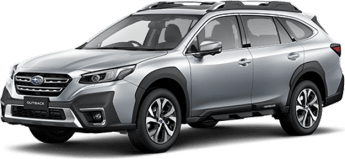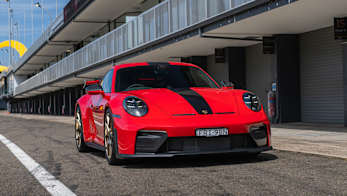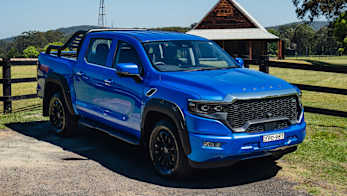A Venn diagram describing conventional cars in one circle and SUVs in another would have an intersection field with the Subaru Outback smack in the middle of it. Looks close to a 'normal' wagon with a hint of macho cladding here and there, but has enough off-highway ability to pass the SUV pub test.
Often referred to as a crossover, this all-wheel drive, five-seater not only takes its name from our very own red centre, but it’s become an Aussie favourite. And this sixth generation model takes the fight up to the competition on both sides of the car/SUV divide.
Subaru Outback 2022: AWD Touring
| Engine Type | Flat 4, 2.5L |
|---|---|
| Fuel Type | Unleaded Petrol |
| Fuel Efficiency | 7.3L/100km (combined) |
| Seating | 5 |
| Safety Rating |
|
Does it represent good value for the price? What features does it come with?
8 / 10
At $47,790, before on-road costs, the top-shelf Outback Touring swims in the same bubbling hot market cauldron as competitors like the Hyundai Santa Fe, Kia Sorento, Skoda Octavia wagon, and Volkswagen Passat Alltrack.
It sits at the pointy end of a three model pyramid, and as well as the substantial engineering and safety tech it carries the Touring boasts a solid standard equipment list including, Nappa leather accented seat trim, eight-way power adjustable heated driver and front passenger seats (with dual memory driver’s side), heated rear (outer two) seats, leather-trimmed gearshift and heated (multi-function) steering wheel, dual-zone climate control, and an 11.6-inch LCD multimedia touchscreen.

There’s also, Apple CarPlay and Android Auto compatible Harman Kardon audio with nine-speakers (subwoofer and amp), digital radio and a single CD player (!), a 4.2-inch LCD info display in the instrument cluster, satellite navigation, an electric sunroof, 18-inch alloys, auto power-folding (and heated) exterior mirrors with position memory and auto dipping on the passenger side, LED auto headlights, as well as LED DRLs, fog lights and tail-lights, keyless entry and (push-button) start, auto function on all side door windows, a power tailgate, and auto rain-sensing wipers.
More than competitive for an under-$50K family-focused package.
Is there anything interesting about its design?
7 / 10
At the 2013 Geneva Motor Show Subaru pulled the covers off its first ‘Viziv’ design concept; a compact coupe, crossover-style SUV created to project the brand’s future look and feel.
A large grille dominated a bold new face flanked by angular headlight graphics, with a subtle blend of hard geometric shapes and softer curves throughout the rest of the car.
Another half a dozen Viziv show cars - large, small, and in between - have since been created and the current Outback clearly reflects the overall direction.
The big, six-sided grille sits between angry tapering headlights with a rugged-looking satin black bumper dividing it from another broad air intake underneath.

Tough wheel arch mouldings continue the theme, with chunky plastic cladding protecting the rocker panels, and thick roof rail mouldings increasing the car’s visual height.
This Touring model features silver mirror shells (body colour on the base car and black on the Sport), and the same treatment on the roof rails.
At the back, jagged tail-lights echo the C-shaped LED pattern of the DRLs up-front, and a large spoiler sits at the top of the rear door to effectively increase the roof’s length and improve aero performance.
And there are nine colours to choose from - 'Crystal White Pearl', 'Ice Silver Metallic', 'Crimson Red Pearl', 'Crystal Black Silica', 'Brilliant Bronze Metallic', 'Magnetite Grey Metallic', 'Dark Blue Pearl', 'Storm Grey Metallic', and 'Autumn Green Metallic.'

So, the exterior reflects a distinctively Subaru look, and the interior is no different. A relatively restrained tone is set by a muted colour palette covering light and dark grey as well as high-gloss black surfaces accented with brushed metal and chrome surrounds.
The central 11.6-inch, vertically-oriented multimedia screen adds a compelling (and user-friendly) touch of tech, while the main instruments are split by a 4.2-inch digital screen displaying a broad range of info.
Simple, low-fuss leather-faced seats look and feel good while ergonomically, switches and major controls are easy and intuitive to use.
And a big shout out for a volume control knob, located on the driver’s side of the centre stack. Yes there’s an up/down switch on the steering wheel, but (call me old school) a physical dial makes life so much simpler and safer than slicker ‘buttons’ built into a touchscreen when you want to adjust the audio volume quickly.

How practical is the space inside?
9 / 10
At close to 4.9m long, 1.9m wide, and 1.7m high the Outback casts a sizable shadow, and interior space is generous.
There’s plenty of head, leg, and shoulder room up front, and the all-important rear seat is equally expansive. At 183cm (6’0”) tall I was able to sit behind the driver’s seat, set for my position, enjoying lots of legroom, and despite the standard sunroof’s inevitable intrusion into the rear part of the roof, plenty of headroom, too. The rear seats also recline, which is nice.
Subaru’s interior design team clearly kept family functionality top-of-mind with numerous storage, media and power options on-board.
For power there’s a 12-volt socket in the glove box, and another in the boot, as well as two USB-A inputs in the front and two in the back.

The front centre console houses two cupholders and there are big bins in the doors with recesses for large bottles. The glove box is a decent size and a sunglass holder swings out of the overhead light unit.
A deep storage box/armrest between the seats features a dual-action lid that, according to which tab you pull, opens the whole thing or a shallow tray for quick access to loose items.
A fold-down centre armrest in the rear seat incorporates a pair of cupholders, there are map pockets on the back of each front seat, as well individual air vents (always welcome), and again there are bins in the doors with room for bottles.
Open the (hands-free) power tailgate and with the rear seat in place you have 522 litres (VDA) of boot space at your disposal. Enough to swallow our three-piece suitcase set (36L, 95L, and 124L) as well as the bulky CarsGuide pram, with heaps of room to spare. Impressive.

Drop the 60/40 split-folding rear seat (via remote handles on either side of the boot space or releases on the seats themselves) and available volume expands to 1267L, which is plenty for a car of this size and type.
Multiple tie-down anchors and pull-out bag hooks are sprinkled around the space, and a small netted section behind the driver’s side wheel tub is handy for keeping bits and pieces under control.
Towing capacity is 2.0 tonnes for a braked trailer (750kg unbraked) and the spare is a full-size alloy. Big tick for that.
What are the key stats for the engine and transmission?
7 / 10
The Outback is powered by an all-alloy, 2.5-litre, horizontally-opposed, four-cylinder petrol engine featuring direct-injection and Subaru’s ‘AVCS’ (Active Valve Control System) operating on the intake and exhaust side.
Peak power is 138kW at 5800rpm, with maximum torque of 245Nm arriving at 3400rpm and hanging around until 4600rpm.

Drive goes to all four wheels via a CVT auto, with eight-speed manual mode, and a specifically CVT-tuned version of Subaru’s ‘Active Torque Split’ all-wheel drive system.
The ATS set-up defaults to a 60/40 front to rear split with a central clutch pack and a variety of sensors determining which wheels can make best use of the available drive from there.
How much fuel does it consume?
7 / 10
Subaru’s official fuel economy figure for the Outback, on the ADR 81/02 - urban, extra-urban cycle, is 7.3L/100km, the 2.5-litre four emitting 168g/km of C02 in the process.
Stop-start is standard, and over several hundred kays’ worth of city, suburban, and (limited) freeway driving we saw a real-world (at the bowser) average of 9.9L/100km, which is acceptable for a petrol-powered car of this size and weight (1661kg).
The engine happily accepts regular 91 RON unleaded, and you’ll need 63 litres of it to fill the tank. That translates to a range of 863km using Subaru’s official economy number, and 636km based on our ‘as tested’ figure.
Warranty & Safety Rating
What safety equipment is fitted? What safety rating?
10 / 10
If you’re ever asked to name Australia’s safest car, you now have the answer (as of late 2021).
In recent testing the sixth-generation Outback reset the benchmark in three of ANCAP’s four assessment categories, earning a maximum five-star rating against the latest 2020-2022 criteria.
It scored a record 91 per cent for ‘Child Occupant Protection’, 84 per cent for ‘Vulnerable Road User Protection’ and 96 per cent for ‘Safety Assist.’ And while not unprecedented, it also recorded 88 per cent for ‘Adult Occupant Protection.’
The latter result included perfect scores in the ‘Side Impact at 60km/h’ and ‘Oblique Pole at 32km/h’ crash tests.
So yeah, pretty impressive, and active tech designed to keep you out of trouble starts with Subaru’s ‘EyeSight2’ system, based on a pair of cameras looking forward from either side of the interior rearview mirror, scanning the road for unexpected events.
EyeSight oversees features including, lane centring, ‘Autonomous Emergency Steering’, lane keep assist, speed sign recognition, lane departure warning and prevention, tyre pressure monitoring, and adaptive cruise control, as well as front, side, and rear view monitors.
There’s also forward and reverse AEB, ‘Steering Responsive’ and ‘Wiper Activated’ headlights’, driver monitoring, blind-spot monitoring, rear cross-traffic detection and alert, lane change assist, and a reversing camera (with washer). We could go on, but you get the idea. Subaru is serious about impact avoidance.
However, if despite all of the above, a sheet metal interface occurs Subaru’s top-shelf safety game continues with, ‘Pre-Collision Brake Control’ (in a crash the vehicle decelerates to a set speed, even if force on the brake pedal drops), and eight airbags (driver and front passenger, driver's knee, front passenger seat cushion, front side and dual curtain).
Subaru’s claiming the front seat cushion airbag as an Aussie first. In a frontal impact the bag lifts the legs of the front passenger, to help suppress forward movement and minimise leg injury.
The bonnet layout is also designed to enlarge collision space to minimise pedestrian injuries.
Top-tether points across the second row allow fitment of three child seat/baby capsules, with ISOFIX anchors included in the two outer positions.
What does it cost to own? What warranty is offered?
7 / 10
All Subaru’s sold in Australia (except those used commercially) are covered by a market standard five-year/unlimited km warranty, with 12 months roadside assistance included.
Scheduled maintenance intervals for the Outback are 12-months/12,500km (whichever comes first) and Capped Price Servicing is available. There’s also a pre-payment option which means you can fold service costs into your finance package.
Subaru Australia’s website details estimated service costs out to 15 years/187,500km. But for reference the average annual cost for the first five years is $490. Not exactly cheap. A FWD Toyota RAV4 Cruiser is less than half that.

What's it like to drive?
8 / 10
Naturally aspirated engines are a rarity in current new cars, but the Liberty features a 2.5-litre non-turbo four matched with Subaru’s ‘Lineartronic’ continuously variable transmission (CVT).
The core premise of a CVT is that it ‘continuously’ delivers the optimal ratio for a best possible balance between performance and efficiency, with improved fuel economy the primary benefit.
Thing is, they typically cause the engine to oddly drone up and down rather than build or lose revs in linear fashion, in parallel with road speed. To old-school drivers they can sound and feel like a slipping clutch.
And without a turbo to add punch low down you have to push the Outback relatively hard to get into the maximum torque band (3400-4600rpm). A comparable turbo four will start to deliver peak pulling power from as little as 1500rpm.

That’s not to say the Outback is sluggish. It isn’t. You can expect 0-100km/h in a little under 10 seconds, which is acceptable for a roughly 1.6-tonne family wagon. And the CVT’s manual mode is a quick way to normalise its quirky personality, using wheel-mounted paddles to shift through eight pre-set ratio points..
Despite running on 18-inch rims, ride quality is good. The Outback rolls on Bridgestone’s Alenza premium SUV rubber and the strut front, double wishbone rear suspension manages to subtly iron out most surface irregularities.
Steering feel is pretty handy, too, and if the mood and opportunity arise, the car points nicely into corners with ‘Active Torque Vectoring’ (by braking) keeping understeer in check. Not surprisingly, it’s an altogether more ‘car-like’ driving experience compared to characteristically taller and higher-riding SUVs.
The ‘Si-Drive’ (Subaru Intelligent Drive) system incorporates an efficiency-focused ‘I mode’ and a sportier ‘S mode’ delivering sharper engine response. Then ‘X-Mode’ manages engine torque, traction control and the all-wheel drive set-up to offer a setting for snow and dirt, and another for deep snow and mud.

We didn’t head off-highway during this test but that extra ability is perfect for outdoor lifestyle lovers wanting safe access to tricky campsites or a low-stress ski trip.
The ‘flat’ four-cylinder’s characteristically pulsing beat makes its presence felt, but other than that noise levels in the cabin are agreeably low.
A single, central media screen is a neat, user-friendly arrangement; the Outback happily side-stepping Subaru’s historical tendency to split functions across multiple smaller screens.
The Harman Kardon audio systems cranks solidly, thanks in no small part to the subwoofer mounted on the passenger side of the boot. The seats remain comfortable over longer stints, and the brakes (ventilated discs all around) are progressive and strong.
Verdict
The new-generation Outback neatly combines family lifestyle-focused practicality and AWD ability. It boasts top-notch safety and competitive value, as well as a civilised driving experience. For those leaning more towards a car than a traditional, high-riding SUV it remains a great option.
Pricing Guides


















.jpg)
.jpg)
.jpg)

.jpg)

